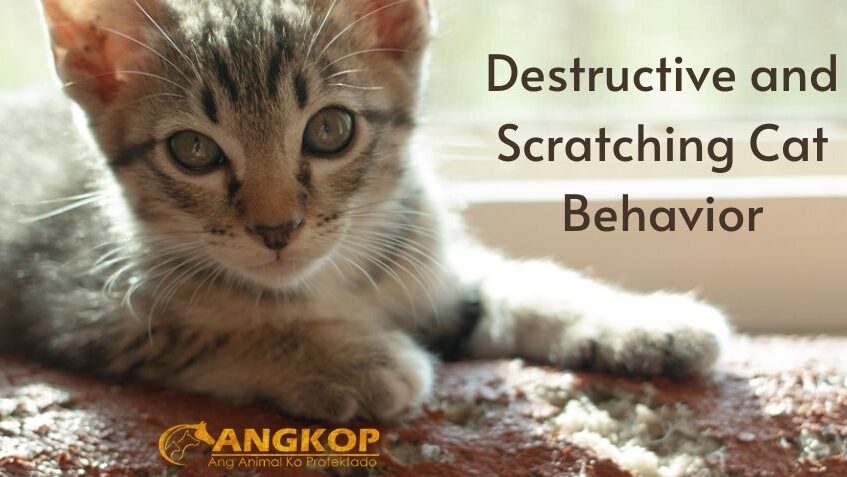Destructive and Scratching Cat Behavior
Behavior that causes damage to an owner’s home or belongings.
Primary destructive behavior is normal behavior that includes exploratory and play-based behavior as well as scratching of surfaces for marking and claw maintenance.
Secondary destructive behavior is a clinical sign reflecting other behavioral conditions and disease states.
SYSTEMS AFFECTED
- Gastrointestinal—damage to teeth; vomiting and diarrhea, obstruction if target items are ingested.
- Musculoskeletal—traumatic damage caused by intense scratching or chewing.
- Ingestion of toxic material could affect any organ system.
SIGNALMENT
- Any breed or gender; probable genetic basis in Oriental breeds that present for sucking or chewing fabric.
- Primary destructive behavior is seen in cats < 6 months of age.
- Secondary destructive behavior is more often in mature animals.
SIGNS
Primary Destructive Behavior
May occur in the presence or absence of the owner.
No specific environmental trigger.
Common targets for scratching are furniture, door frames, and speakers.
May chew houseplants.
Items resembling string, including shoelaces, necklaces, and rubber bands are often chewed and ingested. Small items that are batted, may be accidentally swallowed.
Secondary Destructive Behavior
Attention-seeking-—destructive behavior in the presence of the owner, often when owners are preoccupied.
Compulsive behavior—excessive licking, chewing, and/or ingesting non-food items; fabrics particularly wool are targeted; occurs in the presence or absence of the owner.
Stress-related scratching may occur secondary to household conflict or change or in response to outside triggers, such as non-household cats
CAUSES & RISK FACTORS
Primary destructive behavior represents normal behavior; inadequate supervision and insufficient access to appropriate scratching posts or toys are risk factors.
Owners may reinforce or increase stress by scolding cats scratching inappropriate items.
Compulsive chewing or wool sucking is most common in Oriental breeds.
DIAGNOSIS
DIFFERENTIAL DIAGNOSIS
Rule out medical conditions.
If pica accompanies destructive chewing rule out conditions affecting digestion, absorption, and appetite, including recent diet change.
For the sudden onset of chewing in a mature cat rule out oral, gastrointestinal, and medical disease and medical conditions associated with pain or anxiety.
CBC/BIOCHEMISTRY/URINALYSIS
Usually normal
OTHER LABORATORY TESTS
As indicated to rule out medical condition (T4).
IMAGING
As needed to rule out medical conditions.
DIAGNOSTIC PROCEDURES
Physical examination with attention to the oral cavity.
TREATMENT
Treat any underlying disease.
PRIMARY DESTRUCTIVE BEHAVIOR
Keep claws trimmed.
Supervise/confine until appropriate behavior patterns have been established.
Assure access to acceptable scratching substrate; place posts in prominent locations and in the target area; select suitable substrate—sisal, cardboard, and loosely woven carpet are preferred; avoid posts covered with a tightly woven carpet; position vertical or horizontal based on cat’s preference.
Reward appropriate behavior.
Interrupt inappropriate behavior—apply non-toxic bitter-tasting product to deter chewing or double-sided sticky tape to deter scratching.
Provide regular interactive play,
Provide access to appealing toys.
Declawing should not be first-line therapy for normal scratching; while behavior modification is being implemented, plastic claw covers may be applied to prevent further damage.
SECONDARY DESTRUCTIVE BEHAVIOR
Attention-seeking behavior—provide owner-initiated interactions; clicker training; review principles of learning and reinforcement.
Compulsive disorder—identify and reduce sources of anxiety; offer interactive play and appropriate chewable items; some cats will chew rawhide bones; prevent access to target items.
Reduce household conflict, manage to interact aggression.
Block the view of outside cats.
CONTRAINDICATIONS/POSSIBLE INTERACTIONS
TCAs and SSRIs should not be used with monamine oxidase inhibitors, e.g., selegiline.
FOLLOW-UP
PATIENT MONITORING
Weekly follow-up during the initial treatment.
EXPECTED COURSE AND PROGNOSIS
The resolution of normal exploratory behavior is usually rapid.
Anxiety-based conditions often require long-term management, including long-term psychotropic medication.
MISCELLANEOUS
AGE-RELATED FACTORS
Rule out medical in adult or senior onset.
PREGNANCY/FERTILITY/BREEDING
Preparturient destructive behavior (nesting).
ABBREVIATIONS
SSRI = selective serotonin reuptake inhibitor
TCA = tricyclic antidepressant
Visit your veterinarian as early recognition, diagnosis, and treatment are essential.
You may also visit – https://www.facebook.com/angkopparasahayop




